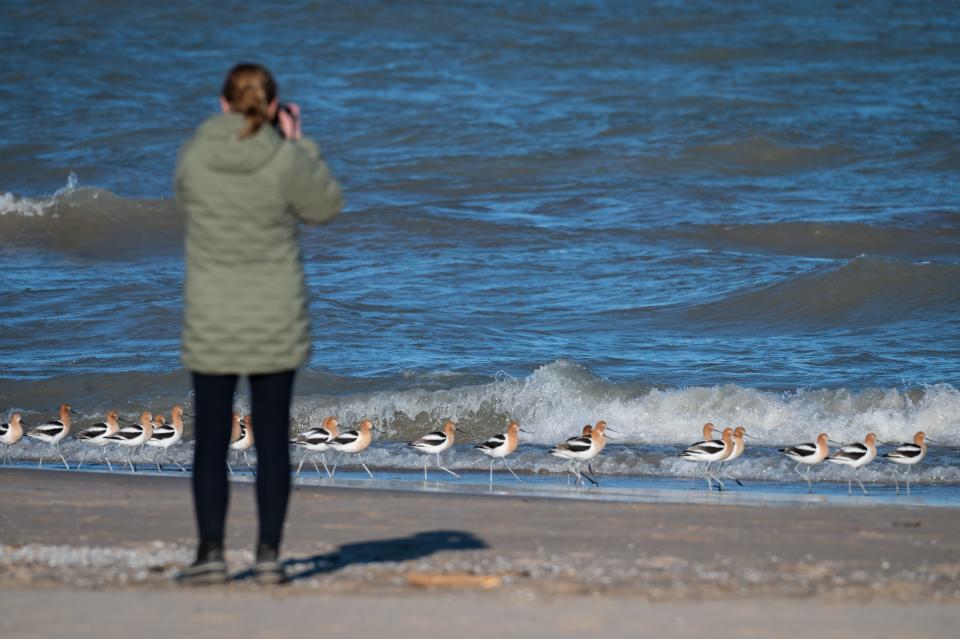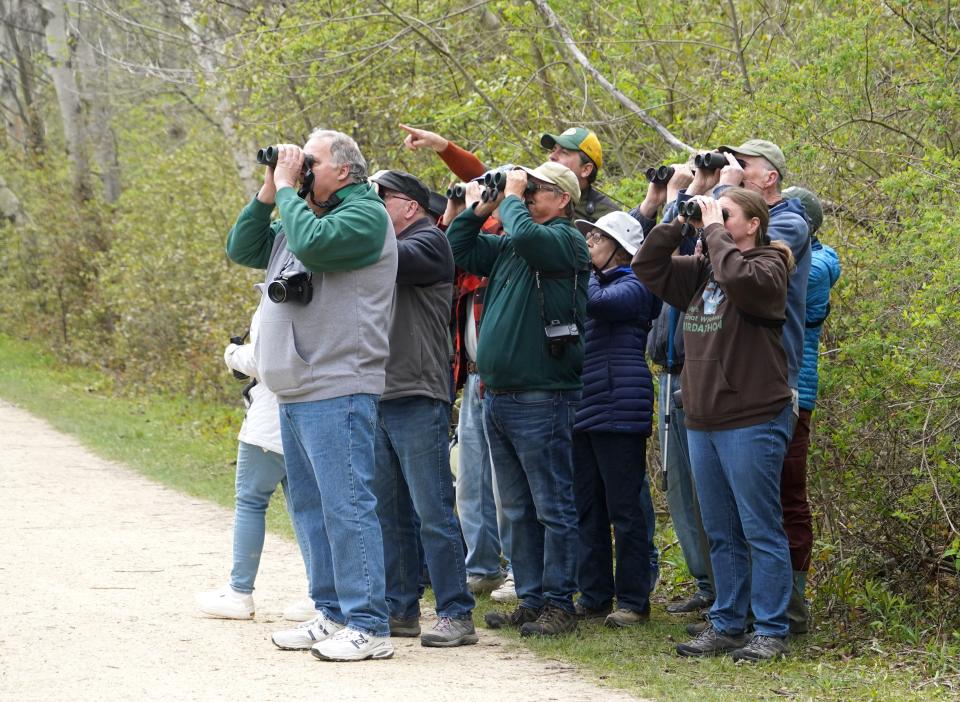Smith: Wildlife watchers and photographers need to give birds more space and respect
The flock of 25 American avocets preened in the mid-day sunshine along the Lake Michigan shore just south of downtown Milwaukee.
It was early May and the birds, on an arduous northerly migration, wouldn't be here long. They stopped on their flight on a strip of undeveloped beach habitat and were getting just what they needed: rest.
It was clear from the birds' behavior they were relaxed. There was no flushing, no fleeing, no heads raised to keep an eye on an approaching threat, no alarm vocalizations.
More: Outdoors calendar
I looked down at them from the top of a bluff about 100 yards away and recorded some video and snapped some photos.
Thankfully for the birds, they were still undisturbed 30 minutes later when I left. I don't know how long their restful stop lasted.
Unfortunately that avocet sighting in 2014 is the only one of 10 I've had over the last decade in southeastern Wisconsin in which the birds were not stressed by humans.
Harassment of migrating birds is a growing problem
In the other nine, people, mostly bird photographers equipped with long telephoto lenses, approached closely to the birds, often within 10 yards, in an effort to capture images.
In each of those sightings the birds were repeatedly forced to flush into flight or run along the beach.
When word spread April 24 of avocets on Bradford Beach in Milwaukee I deliberately didn't go see them because of what I anticipated to be a mob of disrespectful people, including many photographers, competing for "the shot" and stressing the exhausted birds.

More: With spring migration peaking in the Milwaukee area, here are seven top birding spots
Reports from several people who did go see the avocets that day confirmed my fears. The migrating birds were not given the space they deserve, and need, to rest and recharge.
Harassment of migrating birds is a problem I believe is growing at a time most bird populations are declining.
Today news of bird locations travels in real time across social media, alerting thousands of people to the opportunity.
While some wildlife photographers are ethical and respectful of their subjects, far too often I've seen people with cameras motivated to capture a "brag image" so they can post it on social media and generate likes and admiring comments.
They place this selfish goal above the welfare of the birds.
Encroaching on birds and other wildlife can shorten their lives
Watching wildlife, including birds, is one of the leading forms of outdoor recreation in the U.S., according to the U.S. Fish and Wildlife Service. The Service's 2022 survey found 148 million Americans watched wildlife, dwarfing the 40 million who fished and 14 million who hunted.
But some wildlife lovers think because they are involved in a non-consumptive activity – looking through binoculars or capturing images, not directly taking or killing – they are doing no harm to wildlife.
The truth is even birdwatching and wildlife photography can be detrimental to the wild ones.
Hilton Head Audubon in South Carolina has extensive experience with shorebirds. It implores beachgoers and others to give plenty of space to shorebirds to avoid stressing the animals.
"When we cause shorebirds to fly away, they are giving up more than their food, rest, and energy," the group says on its website. "It actually shortens their life."
According to Melissa Chaplin, a biologist with the U.S. Fish and Wildlife Service in South Carolina, "birds exposed to high levels of chronic disturbances have more oxidative stress which damages their body condition."
Over the last several decades I have been privileged to view rare and beautiful birds on hundreds of outings in Wisconsin. Some of the birds were the first documented sighting of the species in state history.
On two recent "firsts," the flame-colored tanager in April 2023 in Cudahy and the varied bunting May 4 in Grafton, the birds drew crowds of people but there was no harassing behavior. The birds remained in foliage yards away from the humans and had plenty of refuge to the east to escape into if desired. At no time did I observe human activity change the behavior of those birds.

On another occasion, the American flamingos in Port Washington, the crowd of about 100 people was mostly very respectful and the birds loafed in the Lake Michigan shallows. While I was there only one person, a photographer with a long lens, waded into the water and attempted to walk closer than about 20 yards to the birds.
And if you're wondering, yes, I called out to him and told him his behavior was disrespectful to the birds. He slowly made his way back to the main group of bird viewers about 45 yards from the birds.
The flamingos flew off from the Port Washington shore later that afternoon. Several birders told me the flamingos left on their own and not because they were flushed by humans. I hope that is the case.
But given the state of social media and recent experiences with flushing shorebirds I'm convinced we need to establish a code of birding and bird photography etiquette in Wisconsin.
Recommendations for respectful birding and wildlife photography
Here's a list of recommendations, many taken from Audubon Guide to Ethical Bird Photography:
Stay at least 100 feet away from shorebirds.
If you cause a bird to make eye contact with you, or flush or run away, you were too close. Slowly back off.
Use a telephoto lens and maintain enough distance to allow your subject to behave naturally. Blinds offer a great way to watch and photograph or record video footage of birds without disturbing them.
Never advance on birds with the intention of making them fly, whether they are lone birds or flocks of birds. This disrupts natural processes such as resting, foraging, or hunting, and causes them to expend energy unnecessarily.
Do not use drones to photograph or record video footage of birds, especially at their nests.
Go see birds and photograph them, yes. But in doing so make sure the top priority is the well-being of the birds and their habitat, not a check mark on a life list or a digital image.
This article originally appeared on Milwaukee Journal Sentinel: Photographers and wildlife watchers need to give birds space, respect

